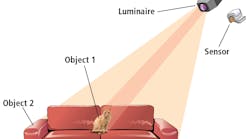With silicon-based LEDs overcoming issues such as lattice-mismatch and refractive-index problems, JOHN ELLIS, chief engineer at Plessey Semiconductors, predicts that the LED industry will move to take advantage of the lower-cost substrate used in the broad IC industry.
Over the last decade, progress in light-emitting diode performance has been nothing less than phenomenal. LEDs today are performing at 50% wall plug efficiency, meaning that 50% of the applied power is emitted as light. Laboratory results are even higher in the high 60s; these results will become standard in due course. In the meantime, LED-based lighting is replacing incandescent, fluorescent, mercury, and sodium lamps in almost all applications. However, the uptake of LED lighting is still limited by the cost of producing LEDs. This one remaining barrier will be addressed by developments in gallium-nitride-on-silicon (GaN-on-Si) technology.
Shuji Nakamura developed a method of growing thin GaN layers on sapphire substrates in the early 1990s, and up to now these have been the foundation of high-brightness blue LEDs. One notable competitor is silicon carbide (SiC), but these substrates are very expensive. While sapphire costs are dropping, silicon is a very common substrate in the semiconductor industry, and the costs are much lower than either sapphire or SiC.
Semiconductors of all types are characterized by the spacing between atoms in the crystal lattice. One difficulty with using silicon as a substrate is that the atoms are not spaced at the same distance as the atoms in a GaN layer. Growing GaN directly on silicon would lead to a mismatch that would cause strain, and this strain would be relieved only through sporadic dislocations that in turn cause leakage currents and general impairment of the performance of the LED.
The breakthrough needed for growing GaN on silicon was to use a buffer layer that offers a better match to the silicon lattice, and then to gradually transpose the buffer layer into GaN. This buffer technology forms the basis of new GaN-on-Si technology. In addition to the buffer layer, considerable optimization has been pursued to reduce residual dislocations, manage the residual strain, and optimize the quantum wells for high-performance LEDs.
GaN-on-Si also requires attention to optical properties. As a substrate, silicon is a good absorber of light — well demonstrated by the number of CMOS imaging chips and photodiodes currently available. The architecture of a highly-efficient LED must eliminate the losses that would occur if the light emitted from the quantum wells in the LED were allowed to enter the silicon.
One method of mitigating the problem is to put a mirror onto the top surface of the LED, transfer the LED and mirror onto a handle wafer, and remove the original substrate. The LED structure is thus turned upside down, and light generated in the junction is reflected upwards.
GaN also has a high refractive index, and as a result has a narrow escape cone with a half-angle of about 23°. Any light that propagates outside of this angle is totally internally reflected. A surface roughening scheme, however, creates a transmissive interface between GaN and air, effectively removing the total internal reflection (TIR) restriction. A lens can further enhance light extraction, increasing the escape cone and providing a refractive index that is closer to the GaN than air.
The techniques described here can deliver lower-cost, high-performance LEDs. The LED is measured in terms of internal quantum efficiency (IQE).
There are several techniques for measuring IQE. The most relevant measure is the overall electrical efficiency. In terms of current, there is a figure of merit that describes output power in terms of watts per unit of current in (W/A). Wall plug efficiency is another measure. The difference between the two is the forward voltage across the diode. Today we can achieve typical forward voltages of about 3.05V. IQE is approaching 60% and light extraction efficiencies are improving to greater than 70%.
Over the next 12 months GaN-on-Si LEDs will match the performance of GaN-on-sapphire LEDs, and offer a substantial price reduction. The move to a silicon substrate will help broaden and accelerate the market for LED-based lighting.






